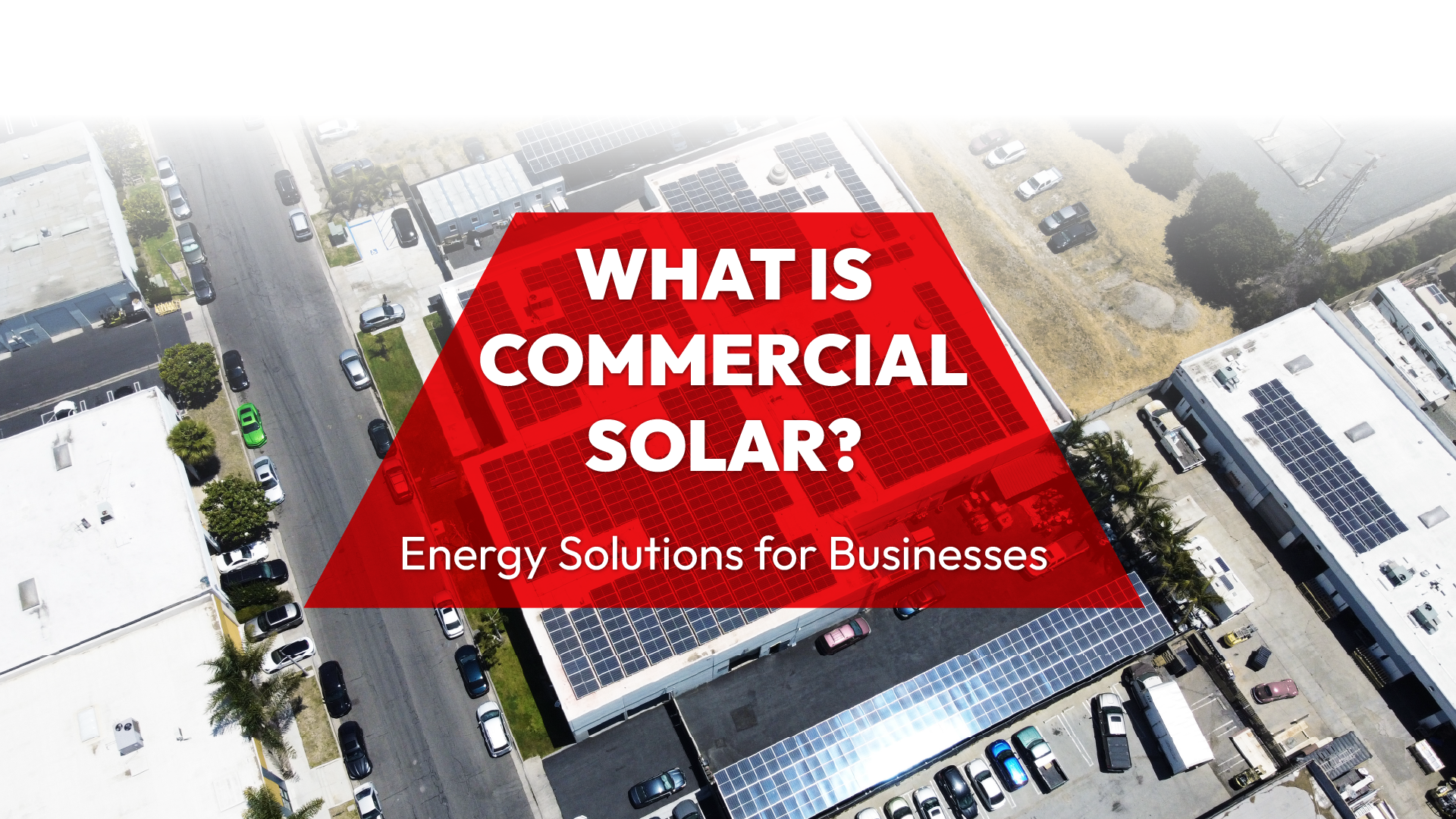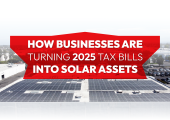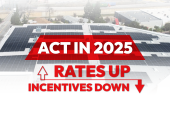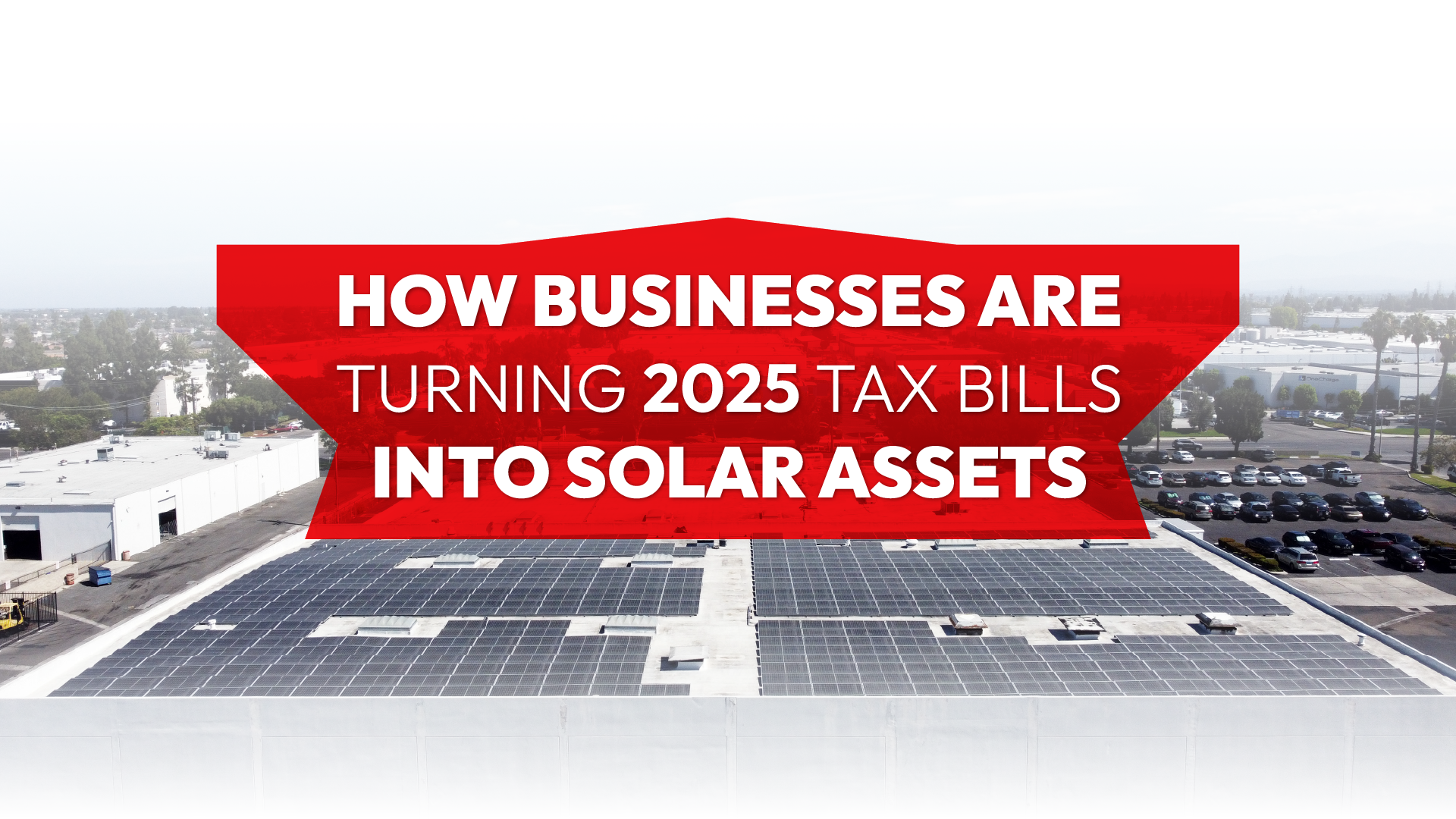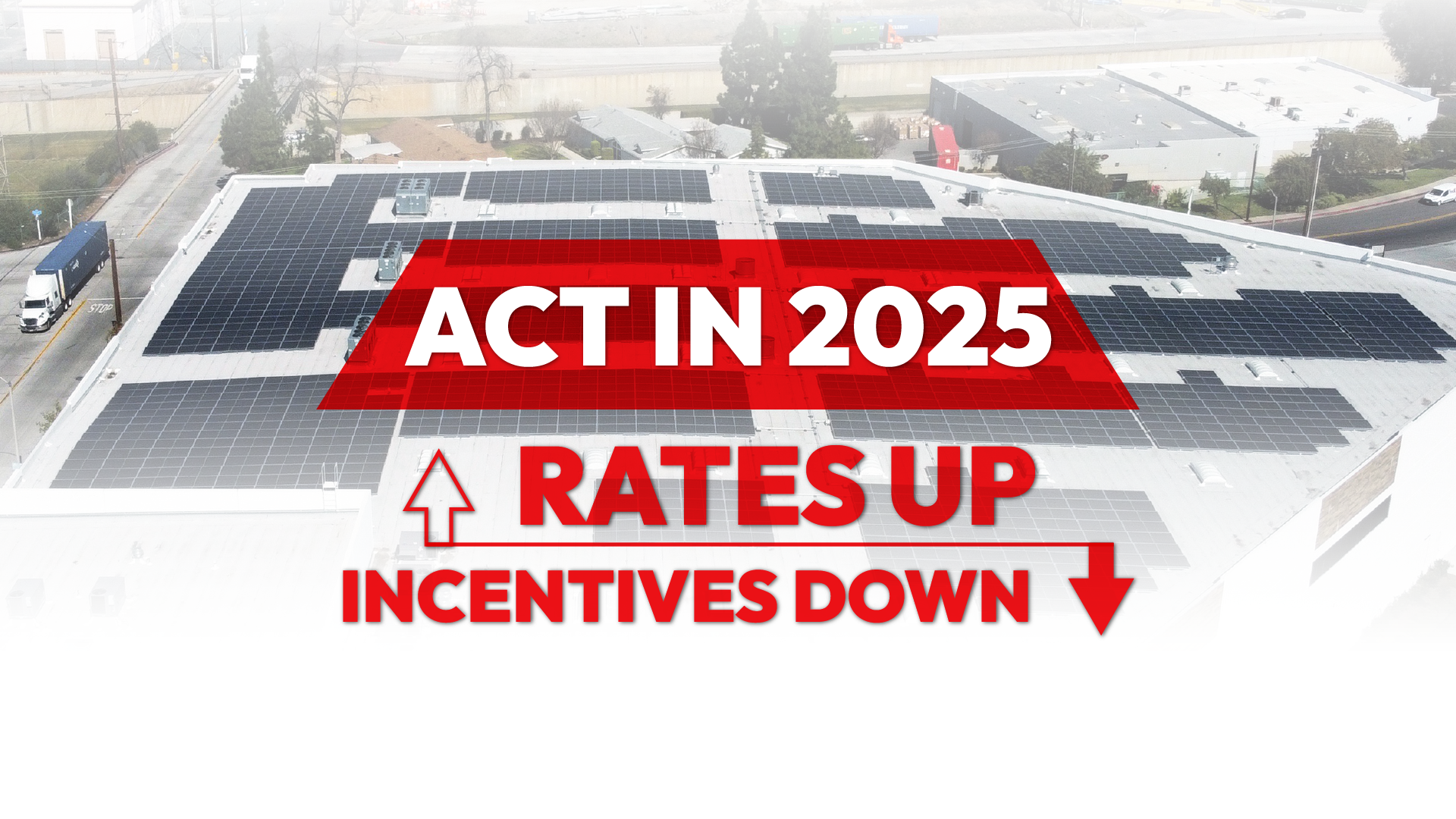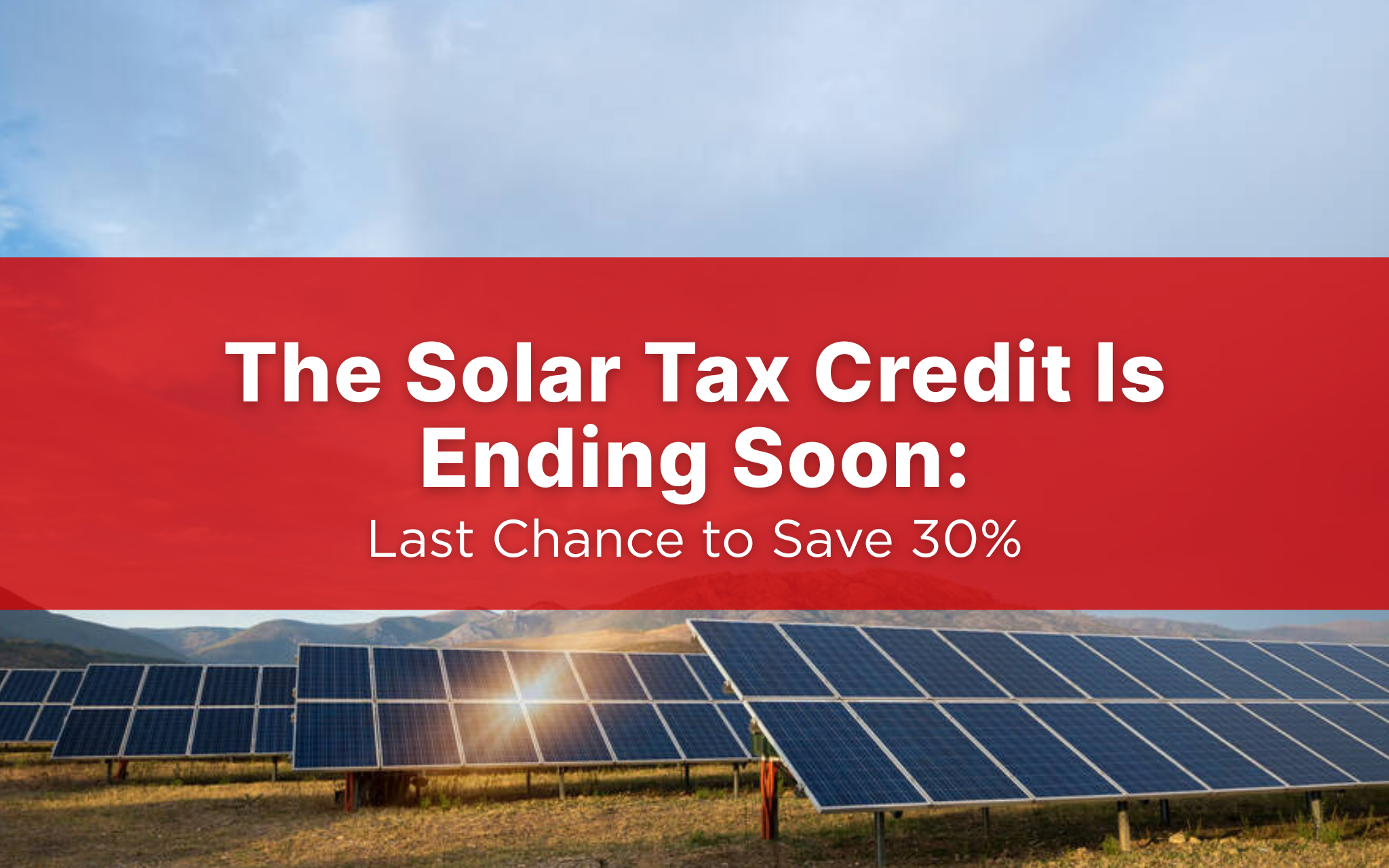High utility bills, market uncertainty, and rising demand for sustainable practices are pushing business leaders to seek smarter energy strategies. Commercial solar offers a proven return on investment—one that lowers operational expenses and shields your business from unpredictable electricity costs.
Thanks to federal incentives, bonus depreciation, and scalable technology, switching to solar is easier and more affordable than ever.
Still wondering what commercial solar really is and how your business can benefit from it?
Let’s break it down.
What is Commercial Solar?
Commercial solar refers to the use of solar energy systems—often large-scale solar panel systems—to generate electrical energy for commercial establishments, industrial facilities, farms, office buildings, and other non-residential properties.
While residential solar systems are typically designed to meet the energy needs of a single household, commercial systems are scaled for energy-intensive operations, often using commercial-grade solar panels installed on building rooftops or open land.
This setup allows businesses to produce their own usable electricity, lowering their dependence on the electricity grid and reducing their exposure to rising energy costs from the utility company.
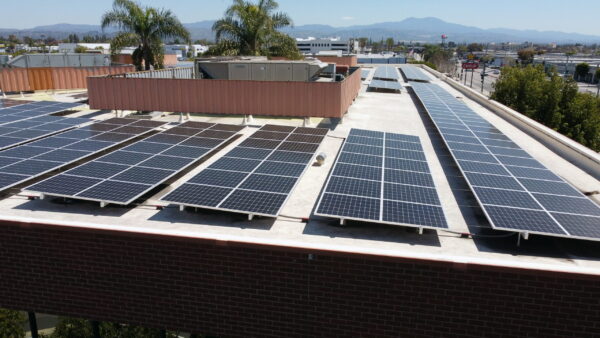
Why Commercial Solar is on the Rise
The commercial solar sector is booming across the U.S. due to a combination of financial, environmental, and operational advantages.
Whether you’re looking to cut expenses, enhance your environmental sustainability, or gain a competitive edge in your industry, solar energy offers a proven path forward. And with numerous financial incentives, it’s more achievable than many business owners realize.
Notably, the U.S. solar industry installed 8.6 gigawatts-direct current (GWdc) of capacity in the third quarter of 2024, marking a 21% year-over-year increase and the most productive third quarter in the industry’s history.
Let’s explore how these benefits translate into tangible gains for your business.
Key Benefits of Commercial Solar for Businesses
From cutting energy bills to demonstrating environmental leadership, commercial solar offers a wide range of advantages that make it an increasingly attractive option for business owners across the country. Below, we outline the most impactful benefits and why companies of all sizes are embracing solar energy systems as part of their long-term strategy.
1. Significant Energy Cost Savings
The most immediate and compelling benefit of going solar is reduced business energy consumption from traditional sources. Once your system is active, it begins generating affordable electricity from sunlight, which can lower your utility bills dramatically.
This is especially valuable for businesses with high daytime energy usage, such as manufacturers, agricultural processors, and large office buildings. In these cases, solar offers:
- Predictable long-term energy savings
- Reduced vulnerability to utility rate hikes
- Lower operational costs and overhead
When combined with battery energy storage, systems can also provide back-up power during outages—further enhancing your business’s energy security.
2. Stronger Environmental Responsibility
Consumers, regulators, and investors are all paying closer attention to corporate sustainability practices. Transitioning to solar power allows your business to demonstrate leadership by reducing its carbon footprint and reliance on fossil fuels.
Solar also helps meet ESG and sustainability goals by generating clean energy without harmful greenhouse gas emissions. For many brands, this positions them as forward-thinking, responsible leaders in their market.
3. Powerful Financial Incentives
To accelerate adoption, governments offer a variety of programs that ease the initial investment in solar:
- Federal Investment Tax Credit (ITC) lets you deduct 30% of your system cost from federal taxes.
- Bonus depreciation allows you to depreciate 40% of your investment in year one for systems placed in service in 2025, expediting your cost recovery .
- State and local solar incentives or rebates can reduce the installation costs even further.
Together, these incentives dramatically improve the economics of solar, especially for commercial customers.
4. Energy Independence and Grid Resilience
Power outages and grid instability are growing concerns for businesses across the country. Solar systems, when paired with energy storage, can provide vital back-up power during extreme weather events or emergencies.
This resilience not only protects your operations, but also improves long-term energy independence, making your company less reliant on utility providers and conventional energy sources.
Exploring Commercial Solar Installations: Which Type is Right for You?
Now that you understand the “why,” let’s look at the “how.”
Commercial solar isn’t one-size-fits-all. Your installation type will depend on factors like available space, energy needs, and budget. Below are the most common configurations:
1. Rooftop Systems
Perfect for commercial property owners with flat or underused rooftops, these systems transform overhead space into a productive solar project. Commercial solar panels typically measure about 6.5 feet by 3.25 feet and weigh around 50 pounds, making them suitable for large-scale installations on commercial rooftops.
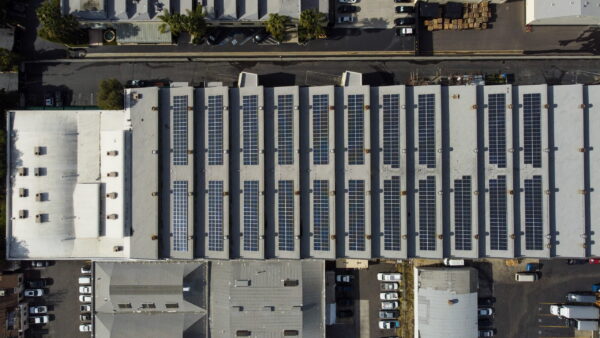
2. Ground-Mounted Systems
These installations are great for businesses with land to spare. They’re highly customizable and often used in agriculture, utility-scale developments, or remote commercial applications. Ground-mounted systems offer flexibility in panel orientation and spacing, which can lead to higher energy yields compared to rooftop systems.
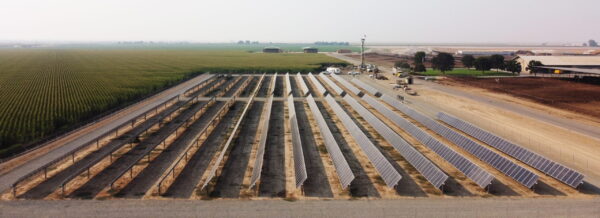
3. Solar Carports
Carports offer dual benefits: power production and shade for vehicles. Ideal for schools, hospitals, and shopping centers, these structures are especially popular in urban settings.
The global commercial solar carport market was valued at approximately $927.31 million in 2022 and is projected to grow at a CAGR of 9.13% from 2023 to 2030, reaching $1,828.45 million by 2030 . This growth is driven by the increasing demand for sustainable energy solutions and the added benefits of utilizing existing parking spaces for energy generation.

4. Utility-Scale Projects
These massive installations, typically over 1 MW, supply power at scale—either for direct onsite use or to feed energy into the electricity grid. These are commonly used by municipalities and large corporations. For instance, the Wolf Run Solar Park in Illinois, operational since November 2024, generates 140 MW of electricity, enough to power approximately 35,000 homes.
How Commercial Solar Works: Step-by-Step
Adopting commercial solar involves more than installing solar panels—it’s a coordinated effort involving permitting, engineering, and sometimes utility negotiation.
Here’s what to expect during the entire process:
1. Design & Feasibility Analysis
Every successful project starts with smart planning. A qualified solar developer assesses your:
- Current energy usage
- Site conditions (e.g., roof, land, shading)
- Budget and financing preferences
- Electrical infrastructure (e.g., electrical panel capacity)
From here, the team will size your system—often 300–400 kW or larger—and create a custom proposal.
2. Permitting & Interconnection
This stage includes obtaining local permits, engineering sign-offs, and coordinating with your utility company for grid connection. It’s crucial to stay compliant with all commercial sector and safety regulations in your electrical field.
3. Installation & Construction
Once permits are approved, the installation process begins. Depending on complexity, it may take several weeks to a few months. Professional solar companies will ensure an efficient installation that maximizes power production and ensures safety.
4. Commissioning & Power-On
After installation, the system is connected to your building’s electric systems and the electricity grid. You may begin generating your own electrical energy, using or storing excess electricity, and potentially earning credits through programs like net metering.
Calculating the Payoff: Is Commercial Solar a Good Investment?
The short answer? Yes.
Even with upfront expenses, the economics of solar are stronger than ever for commercial sectors. Here’s why:
- Installation costs have dropped by over 60% in the last decade.
- The average cost per watt is competitive with traditional energy sources, averaging around $2.00 per watt as of 2024.
- With incentives like the Federal Tax Credit and Bonus depreciation, the initial investment can be recouped faster.
- Systems typically pay for themselves in 5–7 years and then deliver 15–20 years of pure energy savings.
Solar is no longer a fringe option — it’s a mainstream option for companies seeking long-term financial incentives and sustainability goals.
Ready to Take the Next Step Toward Solar?
Commercial solar is more than a cost-saving tool—it’s a catalyst for transformation.
Businesses that invest today are not only reducing their dependence on fossil fuels—they’re leading the way toward a sustainable future and helping shape a more resilient, responsible economy.
From lowering emissions to gaining energy independence and unlocking strong returns, the benefits of solar power extend well beyond your balance sheet.
The solar landscape is evolving—and forward-thinking companies are evolving with it.
Is yours one of them?
Start Your Commercial Solar Journey with Revel Energy
At Revel Energy, we specialize in helping commercial businesses and building owners navigate the full journey of solar installation — from design and financing options to installation and cost recovery. Whether you’re looking for rooftop, ground-mount, or integrated solar + storage systems, our team brings expertise, transparency, and innovation to every project.
Let us help you reduce future energy bills, secure your sustainable future, and achieve your return on investment with commercial solar.
Contact us today to schedule a consultation.
FAQ
Commercial solar refers to solar energy systems designed for commercial applications. Unlike residential panels, commercial panels are larger, more powerful, and engineered to meet the high energy demands of businesses and energy-intensive operations.
It depends on your energy goals. A typical commercial rooftop system needs 5–10 square feet per panel. A 300–400 kW system might need around 20,000–30,000 square feet of space.
The top incentives include the Investment Tax Credit, Bonus depreciation, and various state solar incentives. These can cover 30–50% of the system’s initial cost, depending on your location.
Yes. Excess energy can be stored for later use with battery systems or exported to the electricity grid, where net metering programs may offer financial compensation.
The timeline for commercial installations can range from 2–6 months depending on size, permitting, and complexity of the entire process. Larger utility-scale projects may take longer.
Modern commercial solar panels are low-maintenance. Occasional cleaning and annual inspections are usually sufficient to keep your system efficient and safe.
Yes. With back-up power and energy storage systems, your facility can remain operational during extreme weather events or grid outages, enhancing energy security.
Yes. Studies show that commercial property owners with solar systems often see higher valuations, especially as sustainable features become more desirable to tenants and buyers.
ROOFTOP SOLAR
Commercial grade rooftop solar is ideal for: manufacturing, warehousing, logistics, industrial, retail, hospitality buildings and more with over 10,000 sq. ft. rooftops.
CARPORT SOLAR
Free standing carport solar generates added solar power for properties with limited rooftop space. Added benefits include shading and protection for employees vehicles.
ENERGY STORAGE
Crucial for reducing peak demand charges. Automated to supply electricity when your panels won’t. Energy storage is ideal for businesses that incur significant peak charges.
EV CHARGING STATIONS
As the popularity of EVs increase, so does the demand for on-site EV charging stations. This sustainable amenity has become a parking lot fixture for employers.
CREATING CAPITAL THROUGH SUSTAINABILITY, WE OFFER:
PROFESSIONAL GUIDANCE
CUSTOM TAILORED PLANNING
ENGINEERING, PROCUREMENT, CONSTRUCTION & INSTALLATION
CSLB #1106092
Client Testimonial: Kelemen Company
Corporate Business Park in Irvine, CA has created significant electricity cost savings through commercial solar installed across the 5-building business park.
Client Testimonial: Tice Gardner & Fujimoto LLP
See how this CPA firm saved on electricity and gained valuable tax credits through commercial solar that they used to keep cash in the businesses.

